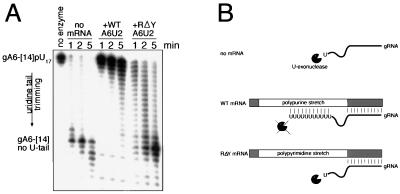FIG. 6.
Polypurine-rich region of the pre-edited mRNA stabilizes the gRNA poly(U) tail. (A) The starting RNA substrate is gA6-[14] with a 17-nucleotide poly(U) tail (gA6-[14]pU17). The substrate RNA and 19S complex from the Q-Sepharose pool was incubated in the absence of mRNA (no mRNA), in the presence of cognate wild-type A6U2 mRNA (+WT A6U2), or in the presence of cognate purine-rich region substitution mutant mRNA (+RΔY A6U2). Products of U-specific 3′ exoribonucleolytic trimming are indicated at the left (gA6-[14] no U-tail). Incubation times are given above the lanes. The arrow labeled uridine tail trimming indicates the direction of product formation. (B) Cartoon depicting reactions shown in panel A. In the absence of cognate wild-type mRNA, the gRNA poly(U) tail is subject to U-specific 3′ exoribonucleolytic trimming. In the presence of cognate wild-type mRNA, the poly(U) tail can hybridize to the polypurine-rich region on the mRNA and thus hinder U trimming. In the polypyrimidine-rich mutant, the U tail cannot base pair with the mRNA and thus is susceptible to U trimming.

